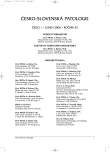Trauma of Cervical Spinal Cord – an Immunohistochemical Study
Poranění krční míchy – imunohistochemická studie
V souboru 11 zemřelých násilnou smrtí bylo provedeno histologické a imunohistochemické vyšetření krční míchy se zaměřením na průkaz lézí bílé hmoty. V nervových vláknech bílé hmoty míšní byla zjišťována pozitivita neuron-specifické enolázy (NSE), přičemž byly porovnávány nálezy u zemřelých s mechanickým traumatem hlavy a krční páteře (7 úmrtí) a zemřelých bez mechanického poranění (4 úmrtí).
Zatímco běžné histologické vyšetření včetně barvení na axony dle Palmgrena nevykazovalo zásadní rozdíly mezi oběma skupinami, v případě detekce NSE byla zjištěna pozitivita reakce převážně u osob s mechanickým traumatem hlavy a páteře.
Klíčová slova:
poranění míchy – imonohistochemie – neuron-specifická enoláza
Authors:
P. Toupalík 1; I. Bouška 1; T. Vojáček 1; J. Ježková 2
Authors‘ workplace:
Ústav soudního lékařství 2. LF UK, Praha
1; Subkatedra soudního lékařství IPVZ, Praha
2
Published in:
Soud Lék., 51, 2006, No. 1, p. 6-8
Overview
The histologica and immunohistochemical examination of cervical spinal cord were used in the group of 11 deceased of violent death. The positivity of neuron-specific enolase (NSE) in axons of cervical spinal cord was examined, and findings in the group of deceased on craniocervical injury (7 cases) and the group of deceased without cranio-cervical trauma (4 cases) were compared. While a routine histological examination including Palmgren’s staining showed no significant differences between bouth groups, we noticed an increased frequency of appearance of NSE deceased with craniocervical injury.
Key words:
trauma of spinal cord – immunohistohemic – neuron-specific enolase
Labels
Anatomical pathology Forensic medical examiner ToxicologyArticle was published in
Forensic Medicine

2006 Issue 1
Most read in this issue
- The Legal Aspects of Manipulation of Dead Body in the Department of Legal Medicine and Pathology
- Trauma of Cervical Spinal Cord – an Immunohistochemical Study
- Postmortem Analysis of the Group of Patients Treated with Implantable Electronic Medical Devices – Study Design
- Identification of Blockers of Adrenergic ß-receptors by Thin Layer Chromatography
